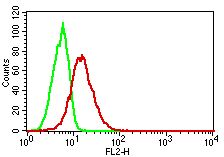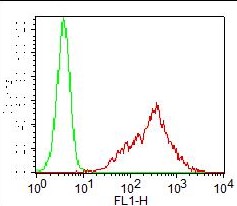Monoclonal Antibody to Human/Mouse TLR2 (Clone : mT2.7)(Discontinued)

Figure-1:Immunohistochemical analysis of Human/Mouse TLR2 (Clone : mT2.7) in human spleen tissue by using 1:50 dilution of anti-TLR2 antibody.
Roll over image to zoom in
Shipping Info:
For estimated delivery dates, please contact us at [email protected]
| Format : | Purified |
| Amount : | 500 µg |
| Isotype : | Mouse IgG2a |
| Content : | 0.5 mg, 0.2 µm filtered antibody solution in PBS, containing 0.02% sodium azide and 0.1% bovine serum albumin. |
| Storage condition : | Product should be stored at 4 °C. Under recommended storage conditions, product is stable for one year. |
Monoclonal antibody 10-3507 reacts with mouse Toll-like receptor 2 (TLR2, CD282). Toll-like receptors (TLR) are highly conserved throughout evolution and have been implicated in the innate defense to many pathogens. In Drosophila toll is required for the anti-fungal response, while the related 18-wheeler is involved in antibacterial defenses. In mammals, TLR identified as type I transmembrane signaling receptors with pattern recognition capabilities, have been implicated in the innate host defense to pathogens. TLR2 has been identified as a receptor that is central to the innate immune response to lipoproteins of Gram-negative bacteria, several whole Gram-positive bacteria, as well as a receptor for peptidoglycan and lipoteichoic acid and other bacterial cell membrane products. A functional interaction between TLR2 and TLR6 in the cellular response to various bacterial products has been discovered. The currently accepted paradigm regards TLR2 as an essential receptor for many eubacterial cell wall components, including lipoproteins and peptidoglycan. Bacterial species as diverse as mycobacteria, spirochetes, mycoplasma, Staphylococcus aureus, and Streptococcus pneumoniae have all been shown to mediate cellular activation via TLR2. The monoclonal antibody mT2.7 stained overexpressed, as well as endogenous cell surface- and intracellular TLR2. The antibody does not affect cell activation through TLR2.
The monoclonal antibody 10-3507 can be used for flow cytometry and immunohistology on frozen sections. Furthermore the antibody is useful for immuno assays and immuno precipitation. The antibody does not affect cell activation through TLR2 (CD282).
For Research Use Only. Not for use in diagnostic/therapeutics procedures.
| Subcellular location: | Cell membrane, Cytoplasmic vesicle, Membrane raft |
| Post transnational modification: | Glycosylation of Asn-442 is critical for secretion of the N-terminal ectodomain of TLR2. |
| Tissue Specificity: | Detected in a macrophage cell line, smooth muscle, lung, spleen, thymus, brain and adipose tissue. Cell surface expression detected in lung alveolar macrophages, dendritic macrophages and at lower levels in lung macrophages (at protein level) (PubMed:19362712). |
|
There are currently no product reviews
|


















.png)












